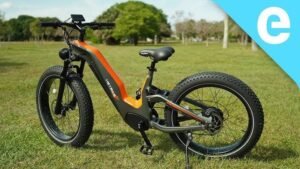Exploring Fat Tire E-Bikes: The Ultimate Guide to Off-Road Electric Biking
Introduction
In the realm of electric biking, fat tire e-bikes have surged in popularity as a go-to choice for outdoor enthusiasts, commuters, and even casual riders looking for a bit more adventure. With their distinctive, oversized tires and powerful electric motors, fat tire e-bikes are designed to conquer a variety of terrains, from sandy beaches and snowy trails to rugged mountain paths. But what exactly makes a fat tire e-bike special? In this guide, we’ll explore everything you need to know about these unique electric bikes, including their benefits, types, and essential buying considerations.
1. What is a Fat Tire E-Bike?
A fat tire e-bike is a type of electric bicycle equipped with larger, thicker tires than traditional e-bikes. Typically, fat tires range from 3.8 to 5 inches in width, providing additional surface area for improved traction and stability on challenging terrain. Coupled with an electric motor, fat tire e-bikes offer a combination of power and control that’s ideal for off-road conditions as well as urban environments where riders might encounter rough surfaces or uneven paths.
2. The Unique Appeal of Fat Tire E-Bikes
a. Enhanced Traction and Stability:
Fat tires have more surface area, which allows them to grip the ground better. This is especially useful on loose or slippery surfaces, such as gravel, snow, mud, or sand. Enhanced traction not only improves safety but also enables smoother rides on challenging trails.
b. Greater Comfort:
The wide tires also act as shock absorbers, softening the impact of bumps and vibrations on rough terrain. This makes fat tire e-bikes more comfortable than their narrower-tire counterparts, even on long rides.
c. Year-Round Versatility:
Fat tire e-bikes are known for their ability to handle various weather conditions, making them a versatile choice for riders who want a bike that can be used in all seasons.
d. Aesthetic and Physical Presence:
There’s no denying the visual appeal of a fat tire e-bike. The oversized tires not only look rugged but also give the bike a commanding presence, often garnering attention and admiration from onlookers.
3. Key Features to Consider When Choosing a Fat Tire E-Bike
When selecting the right fat tire e-bike, it’s essential to consider a few key factors that can impact performance, durability, and overall riding experience.
a. Motor Power and Type:
Fat tire e-bikes come with motors ranging from 250W to 1000W or more. For general off-road use, a motor between 500W and 750W is typically sufficient. However, if you plan on tackling very steep or challenging terrain, opting for a higher-powered motor can make a noticeable difference.
b. Battery Life and Range:
Since fat tire e-bikes tend to be used in rugged conditions, battery range is an important consideration. Look for e-bikes with at least 400Wh to 750Wh battery capacity to ensure that you can enjoy long rides without needing a recharge.
c. Tire Width and Tread Pattern:
Different tire widths and tread patterns are suitable for different terrains. For example, tires with knobby treads work well on dirt trails, while smoother tires are better for beach riding.
d. Suspension System:
Full-suspension fat tire e-bikes provide maximum comfort on rough trails, while front suspension (hardtail) models are lighter and more efficient on smooth surfaces or light trails.
e. Frame Material and Design:
Choose a frame that is both sturdy and lightweight. Aluminum frames are common in fat tire e-bikes, but carbon fiber frames are also available for those looking for a lighter option.
f. Brake System:
Hydraulic disc brakes are often recommended for fat tire e-bikes due to their reliable stopping power, especially on rough or slippery terrain.
4. Benefits of Using Fat Tire E-Bikes
a. Off-Road Capabilities:
Fat tire e-bikes excel at off-road performance, making them a popular choice for riders who want to explore natural landscapes, such as mountains, forests, and beaches.
b. Improved Balance and Control:
The wide tires increase stability, making it easier to maintain balance even at lower speeds or on tricky trails. This feature is particularly beneficial for beginners and those who want a more controlled ride.
c. Eco-Friendly Alternative to Off-Road Vehicles:
Instead of using gas-powered ATVs or dirt bikes, a fat tire e-bike offers an eco-friendly option for off-road exploration. They produce zero emissions and can be recharged at home, which reduces environmental impact.
d. Health and Fitness Benefits:
Although the electric motor assists with pedaling, fat tire e-bikes still provide a significant workout. Riders can enjoy the cardiovascular and muscular benefits of cycling while having the option to ease off when they need a break.
5. Types of Fat Tire E-Bikes
a. All-Terrain Fat Tire E-Bikes:
These are the most versatile models, designed to handle a range of surfaces, from pavements to trails. They’re ideal for riders who want an all-purpose e-bike capable of handling diverse conditions.
b. Beach and Snow Fat Tire E-Bikes:
Beach and snow fat tire e-bikes feature specialized tires with tread patterns optimized for loose surfaces like sand or snow. These bikes are great for coastal areas or snowy regions.
c. Mountain Fat Tire E-Bikes:
Mountain fat tire e-bikes come with enhanced suspension systems and powerful motors to navigate steep, rugged trails. These models are best for adventure-seekers who frequently ride in mountainous terrain.
d. Urban Fat Tire E-Bikes:
While fat tire bikes are often associated with off-road use, urban models are gaining popularity. These e-bikes are ideal for city commuting and come with additional features like fenders and rear racks for carrying cargo.
6. Tips for Maintaining Your Fat Tire E-Bike
Owning a fat tire e-bike comes with unique maintenance needs, particularly related to tire upkeep and electric components.
a. Regular Tire Checks:
Fat tires can lose pressure more quickly than standard bike tires due to their larger volume. Regularly check and adjust tire pressure to ensure optimal performance and comfort.
b. Battery Care:
To maximize battery lifespan, avoid letting it drop to 0% charge, and store it at moderate temperatures. Regularly charge the battery after use, especially if it’s being used frequently.
c. Cleaning and Lubrication:
After riding in muddy or sandy conditions, thoroughly clean the e-bike, paying attention to the chain, gears, and tires. Applying lubricant to moving parts can help prevent rust and ensure smooth operation.
d. Brake System Inspection:
The brakes on fat tire e-bikes may wear out faster due to the bike’s added weight and usage in challenging conditions. Regularly inspect and, if necessary, adjust or replace brake pads to maintain braking efficiency.
7. Top Fat Tire E-Bike Models in 2024
To help narrow down your options, here are some popular fat tire e-bike models in 2024 known for their quality and performance:
RadRover 6 Plus by Rad Power Bikes: Known for its powerful motor, comfortable ride, and high capacity battery.
Juiced Bikes RipCurrent S: Offers a long battery life, great for extended off-road trips.
Aventon Aventure: A full-featured fat tire e-bike with an excellent balance between price and performance.
Himiway Cruiser: This model combines durability with a long range, suitable for riders who enjoy longer commutes or trail rides.
QuietKat RidgeRunner: Designed for hunting and rugged terrain, this e-bike has top-tier off-road capabilities.
8. Choosing the Right Fat Tire E-Bike for You
Selecting the perfect fat tire e-bike comes down to personal preferences and needs. Here are some questions to guide your decision:
Where do you plan to ride most often? If your primary riding location is the beach or snowy trails, look for a bike with tires optimized for those surfaces.
How much power do you need? For frequent off-road use, a bike with a 750W motor or higher will provide the necessary power.
What’s your budget? Fat tire e-bikes vary widely in price. Set a budget based on the features and specifications that are most important to you.
Conclusion
Fat tire e-bikes open up new possibilities for cycling enthusiasts, from exploring difficult terrain to enhancing everyday commutes with added comfort and stability. With their distinctive design and powerful electric assist, these bikes are transforming the biking experience for a wide range of riders. By understanding the unique features, benefits, and types of fat tire e-bikes, you can choose a model that perfectly matches your lifestyle and adventures. Whether you’re an off-road explorer, an urban commuter, or someone looking for an eco-friendly transportation alternative, a fat tire e-bike might just be the perfect ride for you.














Post Comment